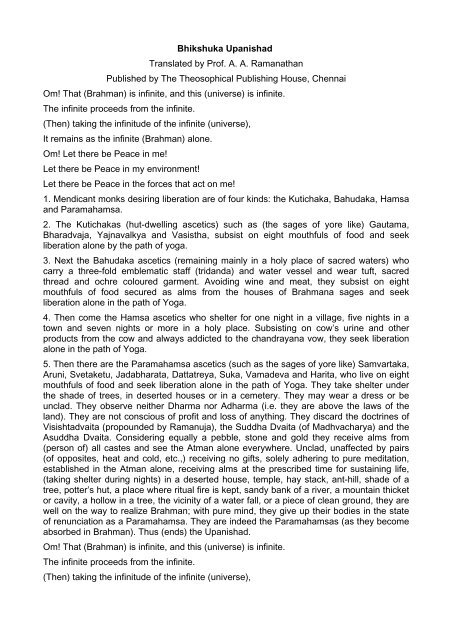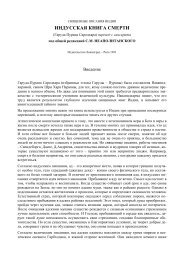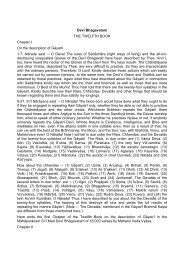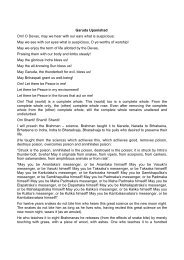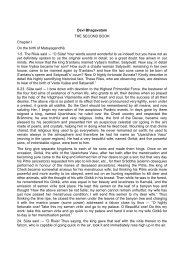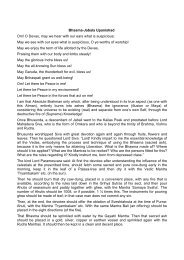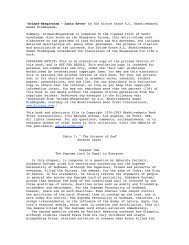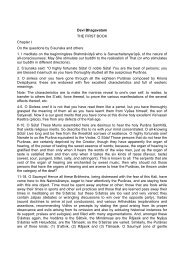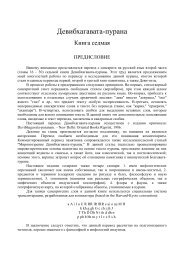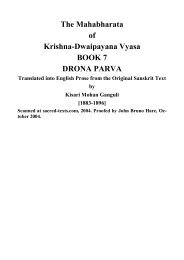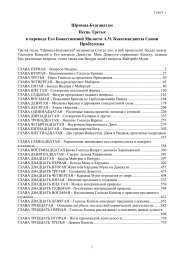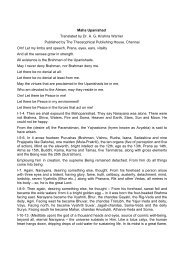Bhikshuka Upanishad _eng
Bhikshuka Upanishad _eng
Bhikshuka Upanishad _eng
You also want an ePaper? Increase the reach of your titles
YUMPU automatically turns print PDFs into web optimized ePapers that Google loves.
<strong>Bhikshuka</strong> <strong>Upanishad</strong><br />
Translated by Prof. A. A. Ramanathan<br />
Published by The Theosophical Publishing House, Chennai<br />
Om! That (Brahman) is infinite, and this (universe) is infinite.<br />
The infinite proceeds from the infinite.<br />
(Then) taking the infinitude of the infinite (universe),<br />
It remains as the infinite (Brahman) alone.<br />
Om! Let there be Peace in me!<br />
Let there be Peace in my environment!<br />
Let there be Peace in the forces that act on me!<br />
1. Mendicant monks desiring liberation are of four kinds: the Kutichaka, Bahudaka, Hamsa<br />
and Paramahamsa.<br />
2. The Kutichakas (hut-dwelling ascetics) such as (the sages of yore like) Gautama,<br />
Bharadvaja, Yajnavalkya and Vasistha, subsist on eight mouthfuls of food and seek<br />
liberation alone by the path of yoga.<br />
3. Next the Bahudaka ascetics (remaining mainly in a holy place of sacred waters) who<br />
carry a three-fold emblematic staff (tridanda) and water vessel and wear tuft, sacred<br />
thread and ochre coloured garment. Avoiding wine and meat, they subsist on eight<br />
mouthfuls of food secured as alms from the houses of Brahmana sages and seek<br />
liberation alone in the path of Yoga.<br />
4. Then come the Hamsa ascetics who shelter for one night in a village, five nights in a<br />
town and seven nights or more in a holy place. Subsisting on cow’s urine and other<br />
products from the cow and always addicted to the chandrayana vow, they seek liberation<br />
alone in the path of Yoga.<br />
5. Then there are the Paramahamsa ascetics (such as the sages of yore like) Samvartaka,<br />
Aruni, Svetaketu, Jadabharata, Dattatreya, Suka, Vamadeva and Harita, who live on eight<br />
mouthfuls of food and seek liberation alone in the path of Yoga. They take shelter under<br />
the shade of trees, in deserted houses or in a cemetery. They may wear a dress or be<br />
unclad. They observe neither Dharma nor Adharma (i.e. they are above the laws of the<br />
land). They are not conscious of profit and loss of anything. They discard the doctrines of<br />
Visishtadvaita (propounded by Ramanuja), the Suddha Dvaita (of Madhvacharya) and the<br />
Asuddha Dvaita. Considering equally a pebble, stone and gold they receive alms from<br />
(person of) all castes and see the Atman alone everywhere. Unclad, unaffected by pairs<br />
(of opposites, heat and cold, etc.,) receiving no gifts, solely adhering to pure meditation,<br />
established in the Atman alone, receiving alms at the prescribed time for sustaining life,<br />
(taking shelter during nights) in a deserted house, temple, hay stack, ant-hill, shade of a<br />
tree, potter’s hut, a place where ritual fire is kept, sandy bank of a river, a mountain thicket<br />
or cavity, a hollow in a tree, the vicinity of a water fall, or a piece of clean ground, they are<br />
well on the way to realize Brahman; with pure mind, they give up their bodies in the state<br />
of renunciation as a Paramahamsa. They are indeed the Paramahamsas (as they become<br />
absorbed in Brahman). Thus (ends) the <strong>Upanishad</strong>.<br />
Om! That (Brahman) is infinite, and this (universe) is infinite.<br />
The infinite proceeds from the infinite.<br />
(Then) taking the infinitude of the infinite (universe),
It remains as the infinite (Brahman) alone.<br />
Om! Let there be Peace in me!<br />
Let there be Peace in my environment!<br />
Let there be Peace in the forces that act on me!<br />
Here ends the Bhikshukopanishad belonging to the Sukla-Yajur-Veda.


